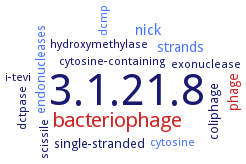3.1.21.8: T4 deoxyribonuclease II
This is an abbreviated version!
For detailed information about T4 deoxyribonuclease II, go to the full flat file.

Word Map on EC 3.1.21.8 
-
3.1.21.8
-
bacteriophage
-
nick
-
phage
-
strands
-
single-stranded
-
endonucleases
-
coliphage
-
i-tevi
-
cytosine-containing
-
cytosine
-
hydroxymethylase
-
dcmp
-
exonuclease
-
scissile
-
dctpase
- 3.1.21.8
- bacteriophage
- nick
- phage
- strands
-
single-stranded
- endonucleases
-
coliphage
- i-tevi
-
cytosine-containing
- cytosine
-
hydroxymethylase
- dcmp
-
exonuclease
-
scissile
- dctpase
Reaction
endonucleolytic nicking and cleavage of cytosine-containing double-stranded DNA =
Synonyms
denA, EndoII, endonuclease II, endonuclease IV, GIY-YIG enzyme, T4 endonuclease II
ECTree
Advanced search results
Crystallization
Crystallization on EC 3.1.21.8 - T4 deoxyribonuclease II
Please wait a moment until all data is loaded. This message will disappear when all data is loaded.
modeling based on structure of UvrC, PDB code 1YD0. Residues G49, R57, E118, and N130 in the putative catalytic surface are important for substrate recognition and binding. Residues G49 and R57 are essential for normal sequence recognition. and play a role in forming the DNA-binding surface and exposing the substrate scissile bond at the active site. Residues N130 and P127 likely contribute to positioning the catalytic domain correctly. Residue K76, part of a conserved NUMOD3 DNA-binding motif of homing endonucleases found to overlap the MR, affects both sequence recognition and catalysis
Tequatrovirus T4
mutant E118A,crystallized in space group P21 with four monomers in the asymmetric unit. EndoII forms a striking X-shaped tetrameric structure composed as a dimer of dimers, with a protruding hairpin domain providing most of the dimerization and tetramerization interfaces. A bound phosphate ion in one of the four active sites of EndoII likely mimics the scissile phosphate in a true substrate complex. A protruding loop containing a nuclease-associated modular domain 3 element is likely to be involved in substrate binding, as well as residues forming a separate nucleic acid binding surface adjacent to the active site. The substrate would bind to a primary EndoII dimer diagonally over the active sites, requiring significant distortion of the enzyme or the substrate DNA, or both, for simultaneous nicking of both DNA strands. EndoII may bind its substrate inefficiently across the two sites in the dimer, offering a plausible explanation for the catalytic preponderance of single-strand nicks
Tequatrovirus T4


 results (
results ( results (
results ( top
top





